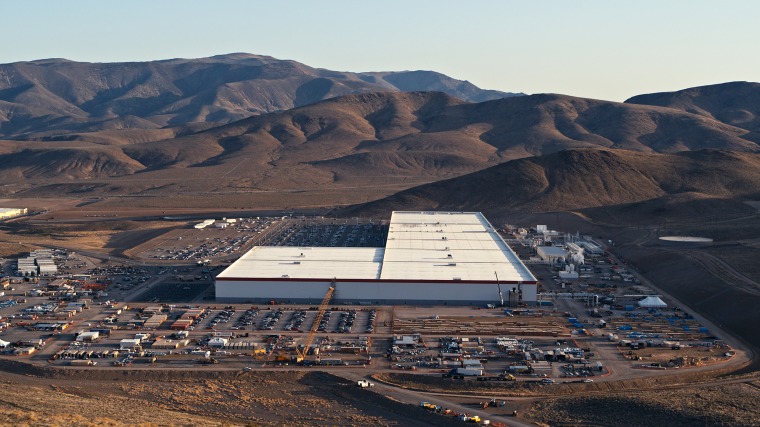President Joe Biden's push for clean energy raises a number of challenges for automakers as the industry shifts towards electric vehicles, including the supply of critical raw materials such as cobalt, nickel and other metals used to make cars — and their batteries.
Currently, the U.S. sources many key ingredients for batteries, notably lithium, cobalt and nickel, from foreign sources — some from allies such as Australia, but often from those, like China, with whom relations are strained.
“A lot of people worry we’re trading fossil fuel dependence for rare earth dependence,” said Kristin Dziczek, vice president at the Center for Automotive Research in Ann Arbor, Michigan.
While the U.S. has fallen behind countries like China, Japan and South Korea, as well as the European Union, in the production of rechargeable batteries, it is trying to catch up. Tesla operates a massive Gigafactory in Reno, Nevada, that produces millions of battery cells each day. General Motors opens its first Ultium battery plant in Lordstown, Ohio, later this year, with a second plant to follow in Spring Hill, Tennessee. Other automakers, such as Ford, are planning battery plants of their own.
Lithium-ion batteries come in various shapes and forms. Tesla uses a cylindrical shape, similar to the batteries in flashlights and other consumer goods. GM’s Ultium cells are pouch-like, or prismatic. They typically have a few grams of the metal each — but that still adds up to about 22 to 25 pounds of lithium for an electric vehicle with a 300-mile range.
Global production of the raw material lithium carbonate equivalent, or LCE, totaled 380,000 tons in 2019. One-third of that is for automotive use, according to a Morgan Stanley study. It takes 5.3 tons to produce one ton of the refined metal, enough for up to 90 all-electric vehicles.
It’s widely believed that battery electric vehicles (BEVs) will generate 30 percent of U.S. vehicle sales by 2030, or somewhere between 5 million and 6 million cars and trucks. That alone would require nearly as much LCE as was produced worldwide in 2019.
A report prepared to mark Biden’s 100th day in office made a number of recommendations, including a call for a national stockpile and even the use of the Defense Production Act to acquire and refine critical minerals. There was also a call to set standards for sustainable mining.
There’s no shortage of mining companies ready to step in to develop local U.S. mineral sources, including Rio Tinto, Lithium Americas and Glencore. In addition, Tesla last September acquired rights to mine its own lithium in Nevada. All claim they will follow strict standards.
Tesla has already acquired the rights to mine its own lithium in Nevada.
But not everyone is convinced by such promises. Environmentalists were up in arms last fall when fields of rare flowers, the Tiehm’s buckwheat, mysteriously died off in northern Nevada. The flowers just happened to be sitting atop some of the lithium deposits that Australian mining company Ioneer wants to exploit. While Ioneer denied harming the flowers, the incident drew attention to the larger environmental issues that underpin the push for clean energy.
The fate of that and other proposed mining projects is now far from certain. And it’s unclear how the White House will move. It has floated several proposals that could turn in drastically different directions. One would subject mines to existing regulations, rather than the tougher guidelines environmentalists seek. Another would have the U.S. turn to friendly foreign sources for critically needed minerals to avoid opening up new mines.
All forms of electrified vehicles, including hybrids and plug-in hybrids, currently account for barely 5 percent of U.S. new car sales. So, even if sales accelerate over the next few years, the U.S. still has some time to line up new sources. Meanwhile, battery companies are working to minimize, even remove, some of the rarer of the rare earths they use — and cobalt, in particular.
There’s another way the industry hopes to hold down the need for new raw material supplies: recycling.
“The last thing we want is to have batteries, the highest-value components, wind up in landfills,” said Aakash Arora, a managing partner and lead author of a study by the Boston Consulting Group looking at the development of a “circular economy” based around used vehicle batteries.

Today’s lithium batteries are proving far more resilient than once anticipated, with most still providing as much as 70 percent or more of their original capacity when the vehicle they’re used in heads to the scrapheap. The BCG study anticipates that by 2030 as much as 30 percent of the high-voltage automotive batteries will find “second life” applications, such as backup power when there’s a brownout or blackout.
The other 70 percent of used automotive batteries would need to be recycled. China currently holds the lead in this industry, said Nathan Niese, associate director at BCG.
LCE currently is trading at around $13,600 a ton, according to data service Trading Economics, a three-year high. That could rise substantially as demand for the refined metal grows. But that also will increase the pressure for more recycling, experts believe.
The question is whether China will dominate that side of the business, as well, or whether the U.S. could establish a domestic battery recycling industry.
For its part, the White House appears ready for the challenge.
"When you look at the way the U.S. has approached the recycling opportunity, what's very evident is we need to invest in that capacity, we need to take a more proactive approach," an administration official told Reuters earlier this month.
"A big part of the lithium opportunity is really recycling, and being a global leader in recycling the lithium from existing batteries and driving that into these new batteries," they said.
